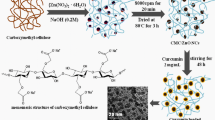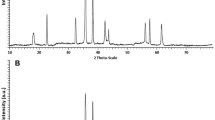Abstract
Cancer is a global disease that is considered as one of the leading causes of death worldwide. The developed resistance toward chemotherapy and radiotherapy, the low degree of selectivity and the accumulation are motivating the efforts to find innovative bio-active systems. The utilization of cellulosic substrates is highly favorable to be used as bio-composites due to their biocompatibility and bioavailability. Two composites with different molar ratios of cellulosic substrates and poly(amidoamine) (PAMAM) hyperbranched polymer have been prepared using a solvent exchange method. The resultant composites were assigned as Comp E and Comp T that prepared by using ethyl cellulose and TEMPO-oxidized cellulose, respectively. The prepared composites were characterized via measurement of overall zeta charge and FTIR. The topography of the composites was investigated using a scanning electron microscope. The evaluation of cytotoxicity and anticancer activity was also studied. The IC50 values from the results of cell viability assays were calculated to investigate the sensitivity of MCF-7, HCT-116, HepG-2, and WI-38 to different types of composites and starting materials. The morphological changes of cancer cell lines were studied using an inverted microscope after different treatments compared to control cells. Higher antitumor activity of polyamidoamine was recorded against tested carcinoma cell lines and lower cytotoxicity was observed against normal cell lines. Also, after a combination of PAMAM with two types of cellulose, the antitumor activity of liver carcinoma cell line was increased for Comp E and Comp T followed by breast and colon carcinoma cells. The biocompatibility of the two types of cellulose was observed against normal cell lines. The cytotoxicity of PAMAM was decreased after combination of two types of cellulose.






Similar content being viewed by others
References
Jemal A, Siegel R, Ward E, Hao Y, Xu J, Murray T, Thun MJ (2008) Cancer Statistics. CA: A Cancer J Clin 58(2):71–96
Fadeyi SA, Fadeyi OO, Adejumo AA, Okoro C, Myles EL (2013) In vitro anticancer screening of 24 locally used Nigerian medicinal plants. BMC Complement Altern Med 13(1):79
Murali MY, Jaggi CCMS (2013) Curcumin nanomedicine: a road to cancer therapeutics. Curr Pharm Des 19(11):1994–2010
Hasanin M, Al Abboud MA, Alawlaqi MM, Abdelghany TM, Hashem AH (2021) Ecofriendly synthesis of biosynthesized copper nanoparticles with starch-based nanocomposite: antimicrobial, antioxidant, and anticancer activities. Biol Trace Elem Res. https://doi.org/10.1007/s12011-021-02812-0
Hasanin M, Hashem AH, El-Rashedy AA, Kamel S (2021) Synthesis of novel heterocyclic compounds based on dialdehyde cellulose: characterization, antimicrobial, antitumor activity, molecular dynamics simulation and target identification. Cellulose 28:8355–8374
Abou-Yousef H, Dacrory S, Hasanin M, Saber E, Kamel SJSC (2021) Pharmacy, biocompatible hydrogel based on aldehyde-functionalized cellulose and chitosan for potential control drug release. Sustain Chem Pharm 21:100419
Tomalia DA, Baker H, Dewald J, Hall M, Kallos G, Martin S, Roeck J, Ryder J, Smith P (1985) A new class of polymers: starburst-dendritic macromolecules. Polym J 17(1):117–132
Esfand R, Tomalia DA (2001) Poly(amidoamine) (PAMAM) dendrimers: from biomimicry to drug delivery and biomedical applications. Drug Discov Today 6(8):427–436
Bielinska A, Kukowska-Latallo JF, Johnson J, Tomalia DA, Baker JR Jr (1996) Regulation of in vitro gene expression using antisense oligonucleotides or antisense expression plasmids transfected using starburst PAMAM dendrimers. Nucl Acids Res 24(11):2176–2182
Kukowska-Latallo JF, Bielinska AU, Johnson J, Spindler R, Tomalia DA, Baker JR Jr (1996) Efficient transfer of genetic material into mammalian cells using starburst polyamidoamine dendrimers. Proc Natl Acad Sci USA 93(10):4897–4902
Tang MX, Redemann CT, Szoka FC (1996) In vitro gene delivery by degraded polyamidoamine dendrimers. Bioconjug Chem 7(6):703–714
Haensler J, Szoka FC (1993) Polyamidoamine cascade polymers mediate efficient transfection of cells in culture. Bioconjug Chem 4(5):372–379
Appelhans D, Klajnert-Maculewicz B, Janaszewska A, Lazniewska J, Voit B (2015) Dendritic glycopolymers based on dendritic polyamine scaffolds: view on their synthetic approaches, characteristics and potential for biomedical applications. Chem Soc Rev 44(12):3968–3996
Basta AH, El-Saied H, El-Deftar MM, El-Henawy AA, El-Sheikh HH, Abdel-Shakour EH, Hasanin MS (2016) Properties of modified carboxymethyl cellulose and its use as bioactive compound. Carbohyd Polym 153:641–651
Hasanin M, El-Henawy A, Eisa WH, El-Saied H, Sameeh M (2019) Nano-amino acid cellulose derivatives: eco-synthesis, characterization, and antimicrobial properties. Int J Biol Macromol 132:963–969
Shehabeldine A, Hasanin M (2019) Green synthesis of hydrolyzed starch-chitosan nano-composite as drug delivery system to gram negative bacteria. Environ Nanotechnol, Monit Manag 12:100252
Abdelraof M, Hasanin MS, Farag MM, Ahmed HY (2019) Green synthesis of bacterial cellulose/bioactive glass nanocomposites: effect of glass nanoparticles on cellulose yield, biocompatibility and antimicrobial activity. Int J Biol Macromol 138:975–985
Hasanin MS, Moustafa GO (2020) New potential green, bioactive and antimicrobial nanocomposites based on cellulose and amino acid. Int J Biol Macromol 144:441–448
Salama A, Hasanin M, Hesemann P (2020) Synthesis and antimicrobial properties of new chitosan derivatives containing guanidinium groups. Carbohydr Polym 241:116363
Abu-Elghait M, Hasanin M, Hashem AH, Salem SS (2021) Ecofriendly novel synthesis of tertiary composite based on cellulose and myco-synthesized selenium nanoparticles: characterization, antibiofilm and biocompatibility. Int J Biol Macromol 175:294–303
Abdellatif FHH, Abdellatif MM (2020) Bio-based i-carrageenan aerogels as efficient adsorbents for heavy metal ions and acid dye from aqueous solution. Cellulose 27(1):441–453
Abdellatif MM, Soliman SMA, El-Sayed NH, Abdellatif FHH (2020) Iota-carrageenan based magnetic aerogels as an efficient adsorbent for heavy metals from aqueous solutions. J Porous Mater 27(1):277–284
Mwafy EA, Hasanin MS, Mostafa AM (2019) Cadmium oxide/TEMPO-oxidized cellulose nanocomposites produced by pulsed laser ablation in liquid environment: synthesis, characterization, and antimicrobial activity. Opt Laser Technol 120:105744
Tang Z, Wei Q, Guo B (2014) A generic solvent exchange method to disperse MoS2 in organic solvents to ease the solution process. Chem Commun 50(30):3934–3937
Cheng Y-L, Chang W-L, Lee S-C, Liu Y-G, Lin H-C, Chen C-J, Yen C-Y, Yu D-S, Lin S-Z, Harn H-J (2003) Acetone extract of bupleurum scorzonerifolium inhibits proliferation of A549 human lung cancer cells via inducing apoptosis and suppressing telomerase activity. Life Sci 73(18):2383–2394
Yingnakhon W, Srikulkit K (2013) A simple quaternization method of hyperbranched polyamidoamine polymer and antimicrobial activity evaluation of cationic hyperbranched polyamidoamine polymer. Asian J Chem 25:4009–4012
El-Saied H, Mostafa AM, Hasanin MS, Mwafy EA, Mohammed AA (2020) Synthesis of antimicrobial cellulosic derivative and its catalytic activity. J King Saud Univ: Sci 32(1):436–442
Ibrahim S, Voit B (2009) Synthesis and characterization of well-defined block copolymers by combing controlled radical and cationic polymerization. Macromol Symp 275–276(1):59–66
Ibrahim S, Abdelfattah I, Soliman O (2016) Environmental recycling of compact disc using industrial wastewater. Pharm Lett 8:207–214
Yabbarov NG, Nikolskaya ED, Zhunina OA, Kondrasheva IG, Zamulaeva IA, Severin ES (2017) Polyamidoamine dendrimers with different surface charge as carriers in anticancer drug delivery. Russ J Bioorg Chem 43(2):155–162
Ernsting MJ, Murakami M, Roy A, Li S-D (2013) Factors controlling the pharmacokinetics, biodistribution and intratumoral penetration of nanoparticles. J Control Release 172(3):782–794
Yamagata T, Morishita M, Kavimandan NJ, Nakamura K, Fukuoka Y, Takayama K, Peppas NA (2006) Characterization of insulin protection properties of complexation hydrogels in gastric and intestinal enzyme fluids. J Control Release 112(3):343–349
Pojo M, Cerqueira S, Mota T, Xavier-Magalhães A, Ribeiro-Samy S, Mano J, Oliveira J, Reis R, Sousa N, Costa BM (2013) In vitro evaluation of the cytotoxicity and cellular uptake of CMCht/PAMAM dendrimer nanoparticles by glioblastoma cell models. J Nanopart Res 15(5):1–9
Hernando M, Rosenkranz P, Ulaszewska M, Fernandez-Cruz M, Fernandez-Alba A, Navas JJA (2012) In vitro dose–response effects of poly (amidoamine) dendrimers [amino-terminated and surface-modified with N-(2-hydroxydodecyl) groups] and quantitative determination by a liquid chromatography–hybrid quadrupole/time-of-flight mass spectrometry based method. Anal Bioanal Chem 404(9):2749–2763
Saska S, Scarel-Caminaga RM, Teixeira LN, Franchi LP, dos Santos RA, Gaspar AMM, de Oliveira PT, Rosa AL, Takahashi CS, Messaddeq YS, Ribeiro SJL, Marchetto R (2012) Characterization and in vitro evaluation of bacterial cellulose membranes functionalized with osteogenic growth peptide for bone tissue engineering. J Mater Sci: Mater Med 23(9):2253–2266
Acknowledgments
The authors have a great and deep thanks for the nanomaterials investigation laboratory, Central laboratory network, National Research Center, and The Regional Center for Mycology and Biotechnology- Al-Azhar University, Cairo, Egypt for kindly material testing.
Author information
Authors and Affiliations
Corresponding authors
Ethics declarations
Conflict of interest
The authors declare that they have no conflict of interest.
Additional information
Publisher's Note
Springer Nature remains neutral with regard to jurisdictional claims in published maps and institutional affiliations.
Supplementary Information
Below is the link to the electronic supplementary material.
Rights and permissions
About this article
Cite this article
Ibrahim, S., Hasanin, M., Ahmed, H.Y. et al. Poly(amidoamine)/cellulose based bio-composites as potential anticancer bio-compatible polymers. Polym. Bull. 79, 8807–8822 (2022). https://doi.org/10.1007/s00289-021-03910-8
Received:
Revised:
Accepted:
Published:
Issue Date:
DOI: https://doi.org/10.1007/s00289-021-03910-8




